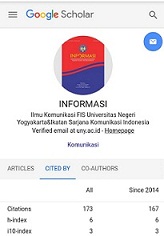Media coverage of DeepFake disinformation: An analysis of three South-Asian countries
DOI:
https://doi.org/10.21831/informasi.v53i2.66479Keywords:
DeepFake, News media, DeepFake detection, Disinformation, News credibilityAbstract
A lot of people are concerned about DeepFakes in modern society. Despite its wide range of uses, DeepFakes has gotten little public recognition. The main goal of this research is to analyze DeepFakes and their originators, as well as their potential and risks. We analyzed 203 news articles from 16 media outlets in Bangladesh, India, and Pakistan to achieve our goal. The extracted news had been categorized under threat, prevention and entertainment centric news. It has been revealed after analyzing DeepFake related news from the leading English daily of these countries that more than 50% news of Pakistani newspapers related to DeepFake was on the threat of this heinous technology. On the other hand, one third news of Indian and Bangladeshi newspapers was on this regard. The widespread broadcast of misleading information through media outlets might boost their legitimacy and reception for a short time but slowly and steadily smear their good name. This study also highlights the significant role media professionals have in spreading disinformation about the people and topics they cover.
References
A. Rossler, D. Cozzolino, L. Verdoliva, C. Riess, J. Thies, and M. Niessner. 2019. FaceForensics++: Learning to Detect Manipulated Facial Images. In ICCV.
Aldwairi, M., & Alwahedi, A. 2018. Detecting Fake News in Social Media Networks. Procedia Computer Science, 141: 215–222. https://doi.org/10.1016/j.procs.2018.10.171
Bates, M. E. 2018. Say What? 'DeepFakes' Are Deeply Concerning. Online Searcher, 42(4): 64.
Benkler, Y., Faris, R., & Roberts, H. (2018). Network propaganda: Manipulation, disinformation, and radicalization in American politics. Oxford University Press.
Broersma, M., & Graham, T. (2012). Social media as beat. Journalism Practice, 6(3), 403–419. https://doi.org/10.1080/17512786.2012.663626
Chadwick, A., & Vaccari, C. (2019). News sharing on UK social media: Misinformation, disinformation, and correction. https:// www.lboro.ac.uk/media/media/research/o3c/Chadwick%20 Vaccari%20O3C-1%20News%20Sharing%20on%20UK%20 Social%20Media.pdf
Chawla, R. 2019. DeepFakes: How a pervert shook the world. International Journal of Advance Research and Development, 4(6): 4–8.
Chesney, B., & Citron, D. (2019). Deep fakes: A looming challenge for privacy, democracy, and national security. Calif. L. Rev., 107, 1753.
Deep Fake Detection Dataset. 2019 https://ai.googleblog.com/2019/09/ contributing-data-to-DeepFake-detection.html Accessed October 29, 2019.
Dobber, T., Metoui, N., Trilling, D., Helberger, N., & de Vreese, C. (2021). Do (microtargeted) DeepFakes have real effects on political attitudes?. The International Journal of Press/Politics, 26(1), 69-91.
Dolhansky, B., Bitton, J., Pflaum, B., Lu, J., Howes, R., Wang, M., & Ferrer, C. C. (2020). The DeepFake detection challenge (dfdc) dataset. arXiv preprint arXiv:2006.07397.
Esser, F., & Umbricht, A. (2014). The evolution of objective and interpretative journalism in the Western press: Comparing six news systems since the 1960s. Journalism & Mass Communication Quarterly, 91(2), 229–249. https://doi.org/10. 1177/1077699014527459
Fletcher, J. 2018. DeepFakes, Artificial Intelligence, and Some Kind of Dystopia: The New Faces of Online Post-Fact Performance. Theatre Journal, 70(4): 455–471. ProjectMUSE, https://doi.org/10.1353/tj.2018.0097
Fletcher, R., Cornia, A., Graves, L., & Nielsen, R. K. (2018). Measuring the reach of "˜fake news' and online disinformation in Europe. Factsheets Reuters Institute (February), 1–10. https://reutersinstitute.politics.ox.ac.uk/our-research/measuringreach-fake-news-and-online disinformation-europe
Godler, Y., & Reich, Z. (2017). Journalistic evidence: Cross-verification as a constituent of mediated knowledge. Journalism, 18(5), 558–574. https://doi.org/10.1177/1464884915620268
Grinberg, N., Joseph, K., Friedland, L., Swire-Thompson, B., & Lazer, D. (2019). Fake news on twitter during the 2016 U.S. presidential election. Science, 363(6425), 374–378. https://doi.org/10.1126/science.aau2706
Gí¼era, D., & Delp, E. J. (2018, November). DeepFake video detection using recurrent neural networks. In 2018 15th IEEE international conference on advanced video and signal based surveillance (AVSS) (pp. 1-6). IEEE.
Guess, A., Nagler, J., & Tucker, J. (2019). Less than you think: Prevalence and predictors of fake news dissemination on Facebook. Science Advances, 5(1), eaau4586. https://doi.org/10.1126/sciadv.aau4586
Guess, Andrew, Brendan Nyhan, and Jason Reifler. 2018. "Selective Exposure to Misinformation: Evidence from the Consumption of Fake News during the 2016 U. S. Presidential Campaign." European Research Council. https://www.dartmouth.edu/~nyhan/fake-news-2016.pdf.
Hamborg, F., Donnay, K., & Gipp, B. 2018. Automated identification of media bias in news articles: an interdisciplinary literature review. International Journal on Digital Libraries. https://doi.org/10.1007/s00799-018-0261-y
Hasan, H. R., & Salah, K. 2019. Combating DeepFake Videos Using Blockchain and Smart Contracts. IEEE Access, 7: 41596–41606. https://doi.org/10.1109/ACCESS.2019.2905689
Humprecht, E. (2018). Where "˜fake news' flourishes: A comparison across four Western democracies. Information, Communication & Society, 1–16. https://doi.org/10.1080/1369118X.2018.1474241
Jordaan, M. (2013). Poke me, I'm a journalist: The impact of Facebook and Twitter on newsroom routines and cultures at two South African weeklies. Ecquid Novi: African Journalism Studies, 34(1), 21–35. https://doi.org/10.1080/02560054.2013.767421
Kaliyar, R. K., Goswami, A., & Narang, P. (2021). DeepFake: improving fake news detection using tensor decomposition-based deep neural network. The Journal of Supercomputing, 77, 1015-1037.
Kovács L (2020) Társadalmi marketing és világjárvány. In: Kovács L (ed) Globális kihívás – lokális válaszok. A koronavírus (Covid19) gazdasági és társadalmi í¶sszefí¼ggései és hatásai. Savaria University Press, Szombathely, pp 195–206
Lewandowsky, S., Ecker, U. K. H., Seifert, C. M., Schwarz, N., & Cook, J. (2012). Misinformation and its correction: Continued influence and successful debiasing. Psychological Science in the Public Interest, 13(3), 106–131. https://doi.org/10.1177/ 1529100612451018
Li, Y., Yang, X., Sun, P., Qi, H., & Lyu, S. (2020). Celeb-df: A large-scale challenging dataset for DeepFake forensics. In Proceedings of the IEEE/CVF conference on computer vision and pattern recognition (pp. 3207-3216).
Lin, H. 2019. The existential threat from cyber-enabled information warfare. Bulletin of the Atomic Scientists, 75(4): 187–196. https://doi.org/10.1080/00963402.2019.1629574
Lippmann, W. (1925). The phantom public. Piscataway, NJ: Transaction Publishers.
Luciano Floridi. Artificial intelligence, DeepFakes and a future of ectypes. Philosophy & Technology, 31(3):317–321, 2018.
Maddocks, S. (2020). "˜A DeepFake Porn Plot Intended to Silence Me': exploring continuities between pornographic and "˜political'deep fakes. Porn Studies, 7(4), 415-423.
Madrigal, A. C. (2017). What Facebook did to American democracy. The Atlantic. http://www.cs.yale.edu/homes/jf/MadrigalFeb2018-2.pdf
Maras, M. H., & Alexandrou, A. 2019. Determining authenticity of video evidence in the age of artificial intelligence and in the wake of DeepFake videos. International Journal of Evidence & Proof, 23(3): 255–262. https://doi.org/10.1177/1365712718807226
Narayan, K., Agarwal, H., Mittal, S., Thakral, K., Kundu, S., Vatsa, M., & Singh, R. (2022). Desi: DeepFake source identifier for social media. In Proceedings of the IEEE/CVF Conference on Computer Vision and Pattern Recognition (pp. 2858-2867).
Pickard, V. (2016). Media failures in the age of Trump. The Political Economy of Communication, 4(2).http://polecom.org/index.php/polecom/article/viewFile/74/264
Rabanser S, Shchur O, Gnnemann S (2017) Introduction to tensor decompositions and their applications in machine learning. arXiv preprint arXiv :1711.10781
Rana, M. S., Nobi, M. N., Murali, B., & Sung, A. H. (2022). DeepFake detection: A systematic literature review. IEEE access, 10, 25494-25513.
Salgado, S., & Strí¶mbäck, J. (2012). Interpretive journalism: A review of concepts, operationalizations and key findings. Journalism: Theory, Practice & Criticism, 13(2), 144–161. https://doi.org/10.1177/1464884911427797
Schifferes, S., Newman, N., Thurman, N., Corney, D., Gí¶ker, A., & Martin, C. (2014). Identifying and verifying news through social media. Digital Journalism, 2(3), 406–418. https://doi.org/10.1080/21670811.2014.892747
S. Lorant. Lincoln; a picture story of his life. Norton, 1969. Fakeapp. https://www.fakeapp.org/. (Accessed on 05/29/2018).
Wagner MC, Boczkowski PJ. 2019. The reception of fake news: the interpretations and practices that shape the consumption of perceived misinformation. Digit J. (2019) 7:870–85. doi: 10.1080/21670811.2019.1653208
Wagner, T.L., & Blewer, A. 2019. "The Word Real Is No Longer Real": DeepFakes, Gender, and the Challenges of AI-Altered Video. Open Information Science, 3(1): 32–46. https://doi.org/10.1515/opis-2019-0003
Walter, N., & Tukachinsky, R. (2019). A meta-analytic examination of the continued influence of misinformation in the face of correction: How powerful is it, why does it happen, and how to stop it? Communication Research, Article 0093650219854600. https://doi.org/10.1177/0093650219854600
Wenzel, A. (2019). To verify or to disengage: Coping with "fake news" and ambiguity. International Journal of Communication, 13, Article 19.
Westerlund, M. (2019). The emergence of DeepFake technology: A review. Technology innovation management review, 9(11).
Whyte, C. (2020). DeepFake news: AI-enabled disinformation as a multi-level public policy challenge. Journal of cyber policy, 5(2), 199-217.
Yu, P., Xia, Z., Fei, J., & Lu, Y. (2021). A survey on DeepFake video detection. Iet Biometrics, 10(6), 607-624.
Zannettou, S., Sirivianos, M., Blackburn, J., & Kourtellis, N. 2019. The Web of False Information: Rumors, Fake News, Hoaxes, Clickbait, and Various Other Shenanigans. Journal of Data and Information Quality, 1(3): Article No. 10.https://doi.org/10.1145/3309699
Zhao, H., Zhou, W., Chen, D., Wei, T., Zhang, W., & Yu, N. (2021). Multi-attentional DeepFake detection. In Proceedings of the IEEE/CVF conference on computer vision and pattern recognition (pp. 2185-2194).
Zi, B., Chang, M., Chen, J., Ma, X., & Jiang, Y. G. (2020, October). WildDeepFake: A challenging real-world dataset for DeepFake detection. In Proceedings of the 28th ACM international conference on multimedia (pp. 2382-2390).
Zimmermann, Fabian, and Matthias Kohring. 2020. "Mistrust, Disinforming News, and Vote Choice: A Panel Survey on the Origins and Consequences of Believing Disinformation in the 2017 German Parliamentary Election." Political Communication 37:215–37. doi:10.10 80/10584609.2019.1686095
Downloads
Published
How to Cite
Issue
Section
Citation Check
License
Authors who publish with this journal agree to the following terms:
- Authors retain copyright and grant the journal right of first publication with the work simultaneously licensed under a Creative Commons Attribution License that allows others to share the work with an acknowledgement of the work's authorship and initial publication in this journal.
- Authors are able to enter into separate, additional contractual arrangements for the non-exclusive distribution of the journal's published version of the work (e.g., post it to an institutional repository or publish it in a book), with an acknowledgement of its initial publication in this journal.
- Authors are permitted and encouraged to post their work online (e.g., in institutional repositories or on their website) prior to and during the submission process, as it can lead to productive exchanges, as well as earlier and greater citation of published work (See The Effect of Open Access).











